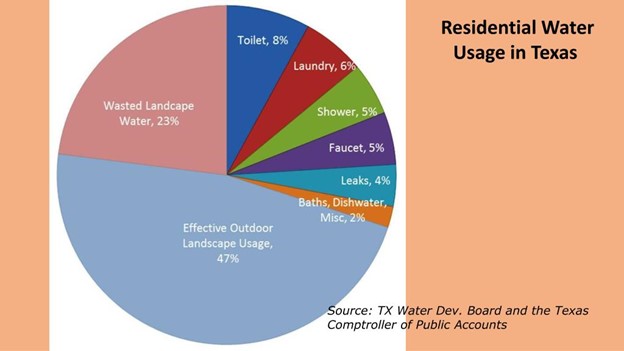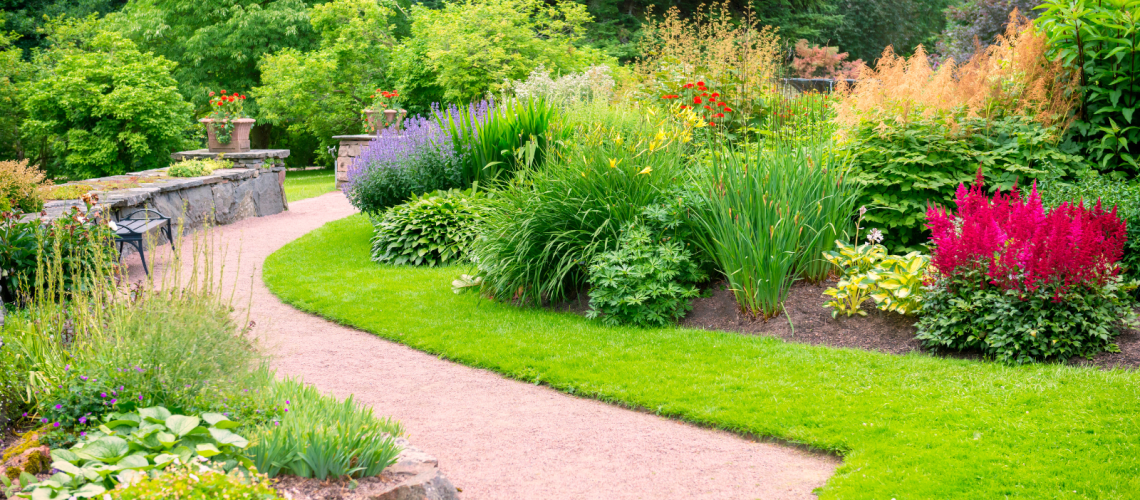Why Reconsider Your Lawn?
TLDR Introduced tropical grasses struggle with the climate in North Texas and require significant resources to maintain.
A Brief History of Lawns
Europe
Lawns originated in the 17th and 18th century in Europe as a status symbol among the wealthy. The practice become popular in France, then the fad spread throughout Europe.
Originally inspired by the grasslands kept short by grazing livestock, lawns were intentionally kept to exhibit wealth. At that time, a typical landowner’s property would have been used for growing crops or housing livestock, so having a manicured green space with no use showcased the landowner’s ability to afford a resource and labor intensive feature.

17th Century Countryside in London, England.
Colonial America
The grasses we see in our American lawns today were not in America until just a few hundred years ago.
Early American settlers found that cattle ate native American grasses far too quickly. To avoid overgrazing and provide for as many cows as possible on a piece of grassland, foreign grasses were imported. Today, many of those imported grasses are still around, either as landscaping turfgrasses, as food for cattle, or as invasive species.
After the importation of foreign grasses begun, early American settlers began to feel more “at home” and traditional European style lawns began to rise in popularity among the colonies. Prior to the late 1800s, lawns were largely a product of the wealthy, and it wouldn’t be until the mid-1900s that the traditional lawn reached the middle class.

Modern America
With the construction of railroads, more people than ever passed through small, unassuming towns. Front lawns in particular gained in popularity at this time owing to the desire for visitors to think highly of these towns.
Again, lawns represented wealth and an orderly community.
Lawn mowers and the garden hose were invented, and the establishment of the lawn care industry took off with additional products like string trimmers, edgers, fertilizers, and herbicides. This made it easier for the average American to have a well-maintained lawn.
Cut to America in the mid-19th century where having a manicured lawn became a symbol of the American Dream and most houses were built with large front yards.
So, What Are Some of the Drawbacks to Maintaining a Traditional Lawn?

Wasted Water
Americans use 9,000,000,000 (9 billion) gallons of water watering their lawns EVERYDAY!
The average American uses 147 gallons of water per day, which equals the average usage by the citizens of Brazil, Germany, UK, China, Honduras, and Somalia combined!
Here in North Texas, 50-70% of this water is used outdoors!

Outdoor landscaping accounts for nearly 70% of water usage in Texas. 23% of that is “wasted,” meaning it never makes it to its intended destination, evaporating or becoming runoff.
Think of the environmental and economical savings we could have if we stopped watering our lawns.
Greenhouse Gas Emissions

Gas-powered lawn equipment account for 4% of the nations annual carbon emissions.
If treated drinking water is used to water the lawn, there is also a carbon footprint associated with the energy needed to treat the water.
Texas’s native grasslands are an important source of carbon sequestration, or the absorption of carbon from the atmosphere. Using native plants in home landscapes can help mitigate urban greenhouse gas emissions.
Chemical Pollution

Americans use 78,000,000 pounds of pesticide and 90,000,000 pounds of fertilizers every year.
Much of these lawn chemicals become runoff and pollute our local water sources. Fertilizer and pesticide contamination can cause algae blooms, fish kills, and water that is not safe for eating fish or swimming.
Many of these chemicals cause illness and death in wildlife and can even cause cancer or other harmful conditions in humans.
If you are using chemicals, be sure to always follow the directions on the label and know that more is not always better. Always do a soil test before choosing fertilizer and look for organic alternatives where possible. Never apply chemicals before rain.
Impact on Wildlife

Home landscapes in the Pacific Northwest, on the East Coast and in the South should NOT look the same.
The US has a vast array of different ecoregions with different climates and conditions, all with their own set of native plants, birds, insects, and other animals which rely on the native ecosystem.
Replacing these diverse ecosystems with a monoculture of foreign grasses with no value to local wildlife results in habitat loss and species extinctions.
Adding native plants to your landscape provides food and shelter for local wildlife! Who doesn’t want to feel like Snow White in their own backyard?
Wasted Space

Lawns are the largest (by area) irrigated crop in the United States occupying more than 40,000,000 acres of land.
That is 3 times more than the area occupied by the second largest irrigated crop, corn.
Significantly reducing these acres to only useable lawn areas would save a substantial amount of water and resources needed to maintain them.
Re-evaluating Your Lawn
There are some benefits to lawns!
Lawns can be used for dogs or other animals, as play spaces for kids, and as places to play sports, however many lawns are non-functional and those are lawns that should be reconsidered. A good rule to go by is if more time is spent mowing or otherwise maintaining the lawn than time spent using it, the lawn is non-functional.
In comparison to bare soil, turfgrass can also control erosion, and compared to concrete, turfgrass provides more localized cooling and water infiltration. However, when compared to native plants, turf’s ability to control erosion, cool local temperatures, and allow for water infiltration is inferior.
We recommend dividing your total home landscape into 3 sections:
-
1/3 functional turfgrass lawn
-
1/3 native plant beds
-
1/3 permeable hardscape
Learn more here: Texas Home Landscape Design Video on YouTube
Create a More Environmentally Friendly Landscape by Reducing Your Lawn!

Ready to replace your lawn with something else? Stay tuned for Turf Alternatives Part 2: Turf Alternatives for ideas!



